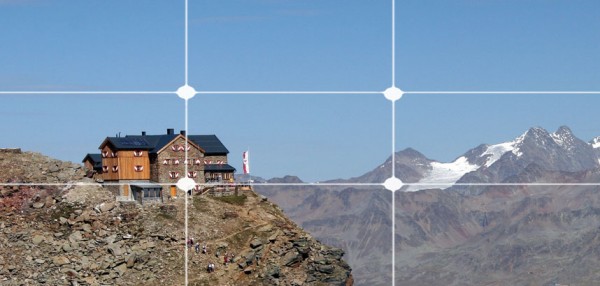
Do it properly and you’ll find that photography is a fantastic way to connect with the environment. When we travel, we’re constantly looking for that authentic, local experience. Use your camera wisely, because not only is it a great lens through which to view the world, it is also a great route to meeting new people and discovering interesting places.
Make sure to travel with your camera to the unique and beautiful Lakes and Mountains this summer. Follow these top photography tips to ensure you return from your holiday with the best photographs, and the most memorable experiences.
Use the rule of thirds

The challenge to taking great photos is composition – get that right and we can almost forgive a bit of over-exposure and blurriness. Experienced photographers follow the rule of thirds, guidelines that help you to create dynamic compositions.
Imagine a photograph divided into a grid of six evenly sized rectangles. By aligning the subject of your photograph on the lines and intersections of the grid you will create a more pleasing image.
This is particularly helpful when composing a landscape photo. Instead of placing the horizon in the centre of the frame, line it up with the one of the horizontal lines. The result is a more dynamic landscape.
Compare:

To:

See? Much better.
Use slow shutter speeds to show speed and motion

This is a great rule for photographers who use a DSLR and have more control over their camera. If you have a camera where you can manipulate the shutter speed, consider using a long exposure for photographs where there is a lot of movement in the frame.
Capturing a sense of movement in your photographs can be a challenge. By using a slow shutter for longer exposures, anything with significant movement in front of the camera will take on a blurred appearance. This is particularly effective for subjects such as waterfalls, or fast moving cyclists.
When taking photos with a slow shutter make sure to use a tripod, or have somewhere stable to support your camera. Long exposures are particularly susceptible to camera shake. Easily change the shutter speed on your DSLR by putting your camera into S-mode (on Nikon and Sony cameras) and TV-mode (on Canon cameras).
Get closer to the action

The famous wartime photographer and photojournalist, Robert Capa once said: “if your photographs aren’t good enough, you’re not close enough.” And he was right.
It can be all too easy to zoom into that interesting building or person in the distance, but to truly capture why that subject is of interest to you, you need to think about the composition. By getting closer to your subject, walking up to and around it/them, you will discover new possibilities for images – and better, more striking photos.
For all their technical achievements, zoom lenses tend not to be as proficient, or as flattering as their standard counterparts. Standard lenses (around 50mm to 85mm) are generally capable of much wider apertures, so you can be more creative with the depth of field. They are also far more suited to portraits. Matching the human field of view, standard lenses give a more naturalistic appearance to images.
Talk to people

As a rule, everyone loves their local area – especially when that area happens to be the beautiful lakes and mountains. Chatting to local people, you are sure to uncover recommendations for the most beautiful views, and hidden landmarks off the beaten path. This is a great way to give your landscape photos a unique and personal twist.
Portraiture makes a beautiful and intriguing addition to any photographic, travel journal. It can be intimidating to ask the people you meet on your holiday if you can take their photograph, but more often than not people are flattered and very willing to pose. The best part is, that by chatting to the people you photograph, they are much more likely to open up – providing you with a more genuine and representative portrait.
Always have your camera ready
You never know when your next photo opportunity may present itself, and it is frequently fleeting moments that make the best photos: the sunlight pouring out from behind a cloud, a rare bird fluttering into view, children at play.
Don’t regret not capturing a photograph because your camera was in your bag! Always have your camera on you, and switched on, ready to take a photo at short notice. Keeping the lens cap off will make you even more prepared. You can invest in a UV or skylight filter for your camera lens, which will ensure it remains protected when the cap is off.
Use these top tips not only to take better photos on your next Lakes and Mountains holiday, but also to get closer to the people and places you visit. Happy snapping!